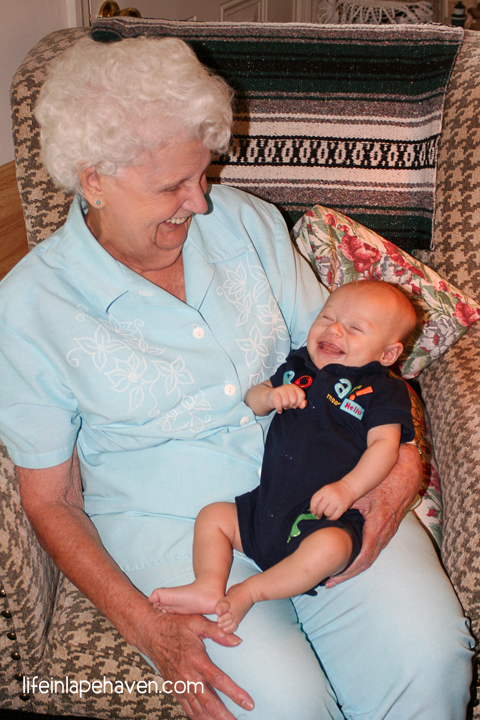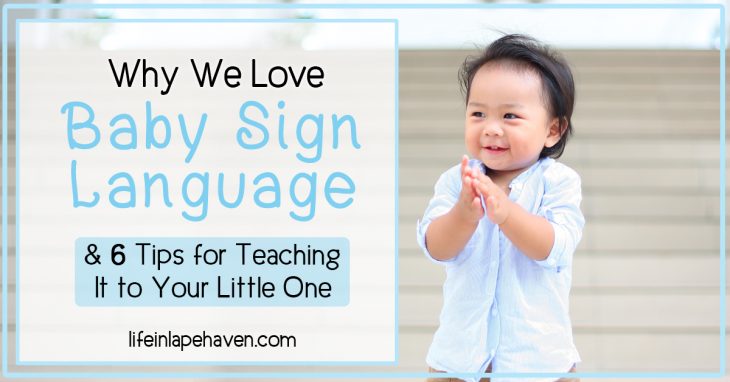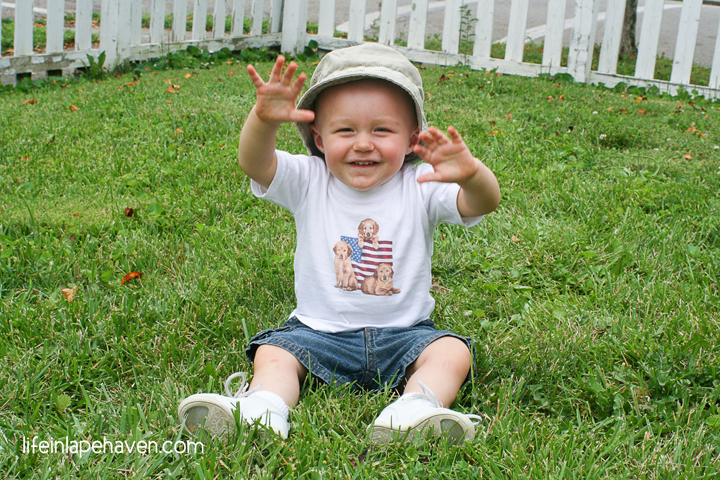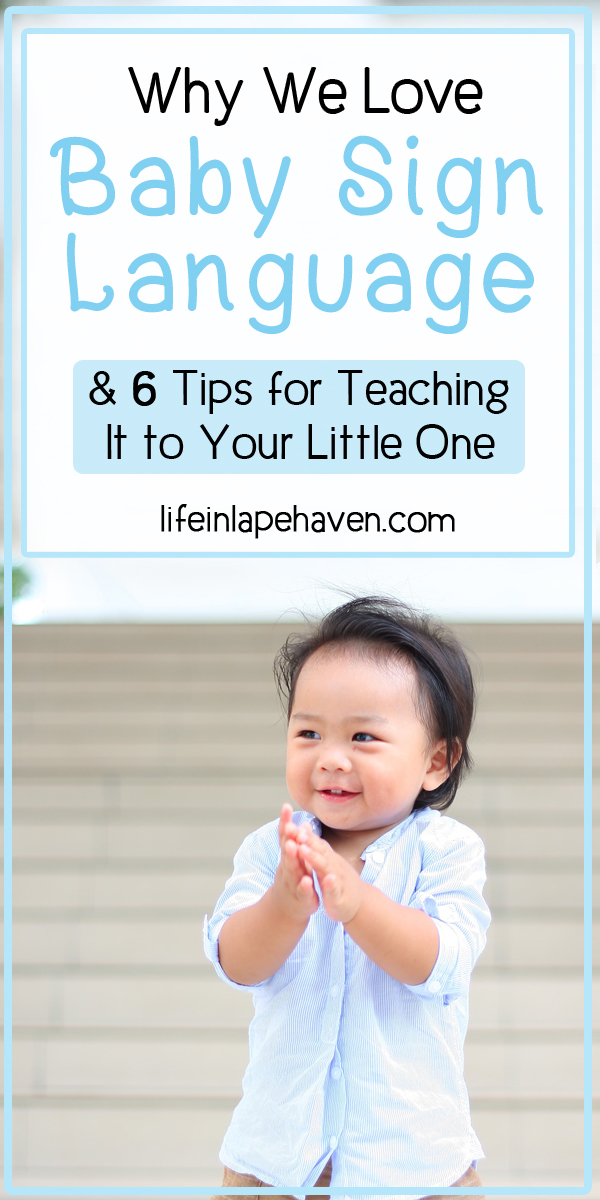When I was pregnant with Elijah, my paternal grandmother gave me two books about how to teach your baby to communicate using sign language. (One even came with flash cards.)
I’ll be honest. At first, I just looked at her. I’d never heard of such a thing.
But Grandma Charlotte was a pretty smart, well-read lady. She’d also taken classes in sign language a few years earlier so that she could communicate with a couple of family members who were hearing impaired, including my cousin’s little girl who is deaf. She knew how easily children could pick it up and how helpful it would be.
So, I read the books, learned some of the basic signs, and taught them to my husband and our parents.
When Elijah was a few months old, I started using the signs as we went through the day, whenever it applied to what we were doing. I’d say the word as I signed it, and soon it became a habit for me.
As Elijah got a little older, we could tell he understood what the signs meant, and, somewhere around 8-9 months, I think, he began signing back.
If you’ve never seen a baby use sign language, it’s kind of amazing – and super cute!
Suddenly, he could ask for a “drink” or let us know when he was “done” or wanted “more.”
We didn’t have to struggle as much with figuring out what he wanted or needed, and Elijah wasn’t whiny or frustrated…unless he was told that he couldn’t have something he wanted. 🙂 Learning “no” is never fun, whether it’s verbal or in sign.
As my family saw how easily Elijah used his signs and how helpful it was, they started using them with his younger cousins.
My grandma was especially proud of our success, and of course, she enjoyed signing to him and seeing him respond happily.
When Josiah came along, there was no question that we would teach him those basic signs as well, this time with Elijah’s help. Sadly, my Grandma Charlotte passed away when Josiah was only 5 months old, so she never really got to see how he benefitted from the communication tool that was her idea.
Now four years later, here we are, teaching a third little boy to use his hands to talk to Mommy, Daddy, and the rest of his family.
Isaiah’s response to sign language was almost immediate because the first one he learned was “milk.” If I wasn’t completely ready to nurse him, but showed him the sign for it, he would get upset pretty quickly! And there were times when I’m pretty sure he signed “milk,” even though he seemed too young to be able to.
Now that he’s at the age where he can mimic our signs easily, it’s been so fun to watch his understanding blossom. He’s been very quick to let us know when he’s “all done” eating, and he loves to tell you when something is “hot,” like the heater or his toy stove with the light-up burner. Haha.
But he picked up a new sign even more quickly last week. After only a couple of demonstrations and connecting the sign with what it meant, he was ready to use “cookie” as often as possible. 🙂
When others see us using signs with our boys, I’ve had them ask me if signing discouraged my children from talking when they were little. Since they could get their message across pretty clearly with just some gestures, after all, why would they need to use words?
Our experience, though, has been that both of our older boys started talking fairly early and easily. While this may be in part because I talked to them ALL THE TIME and prompted them to use words once they were able to, I think that teaching them sign language actually encouraged them to try different kinds of communication because they knew we were paying attention to what they “said.”
Another benefit I’ve found it being able to tell my little ones something without having to say a word, which is especially nice in church when you’re trying to be quiet, or in a noisy place, where your kids might have trouble hearing you. (Being able to sign “no” to even an older child across the room is awesome, especially when you couple it with “the look.”)
If you’d like to begin teaching your child sign language, here are a few tips from our signing experience with our three boys.
6 Tips For Teaching Baby Sign to Your Little One:
1. Start Early
Begin signing even before your baby can physically and developmentally copy them, maybe around 3-4 months old. You’ll get into the habit, & they’ll be learning. (Even if your child is older, you can introduce signing at any age!)
2. Don’t Use Too Many
Pick a few basic signs that you’ll use most often and most effectively and start there. We did ones like Milk, Eat, More, Done, Bath, and Change. You can add others later (Mom, Dad, Please, Thank You, Potty, Dog, Cat, and tons more), just like you build your baby’s verbal vocabulary a little at a time. Here are 21 words you can sign easily.
3. Be Consistent
Use the same sign and word each time and teach your spouse and other family or caretakers to use them, too. (Using standard ASL signs is the best for consistency with others who sign.) We all learn better with repetition. (Our kids can even use their signs in the nursery at church. Several families have taught their children signs, so most of the regular nursery volunteers are pretty fluent in baby sign as well. How cool is that?)
4. Sign in Context
Use the sign when you’re doing the action. Signing “change” makes more sense when you’ve got your little one down and ready to change their diaper, rather than when you’re in the living room and think they might have a dirty diaper. 🙂
5. Don’t Expect Perfection
When your baby starts to sign back, it’s most likely not going to be perfectly executed. Keep in mind your little one is still developing those fine motor skills, so pay attention to anything that even closely resembles a specific sign and respond to it.
6. Keep Signing
Once your child starts talking, there’s no rule that says you have to stop using and teaching them signs. Not only is knowing another language fun and beneficial for challenging their minds (and ours), it will create an instant connection for them with anyone they know/meet who also signs, some who may use sign language as their main form of communication.
Need more help getting started? Here are some fun resources for learning and teaching Baby Sign Language.
(Some of these links are affiliate links, which means that I may receive a small commission if you use the links. You can see my full disclosure for details.)
VIDEOS
One of our favorite sign instructors is Rachel Coleman of Two Little Hands and Signing Time. (We even used her “Potty Time” app when we were potty training Josiah.) Here are just a few of the video available on YouTube.
Baby Signs:
The Potty Time Song:
Best of Two Little Hands TV, featuring signs for foods, clothing, ABCs, colors, and more:
BOOKS
HAVE YOU TAUGHT YOUR CHILD BABY SIGN LANGUAGE? WHAT OTHER TIPS WOULD YOU GIVE?
Get more ideas & encouragement from this real-life mom as I experience God’s faithfulness through the joy and chaos of motherhood.
Join my email list!
YOU MAY ALSO LIKE:
5 Tips & Tricks I Learned with My 3rd Baby that I Wish I’d Known with My 1st







My son’s speech therapist taught my son a handful of words to help him communicate when he wasn’t able to talk at age 2. He was always so frustrated when we didn’t understand his needs prior to this.
It definitely helps when they can communicate even a few basic things! So glad it helped him. 🙂 Thanks for sharing your experience, Tami!
Hey there! I wonder if you could tell me which books your grandmother offered you to read about baby signing?! Thanks a lot🙏
Hi, Isabel! I wanted to include them in my post, but I couldn’t find them at the time. (Isaiah has started pulling books off his shelf – which is where the books should be – and carrying them around, so his books end up EVERYWHERE! Haha.)
I did find one, though, just now. It is called “Baby Sign Language” by Alison Mackonochie. It was a good one to reference because it has a LOT of every day words and decent pictures and descriptions for how to do the signs. It’s listed on Amazon in limited supply – it might be out of print. (This is an affiliate link) http://amzn.to/2GBEPir
When I find the one that came with the flashcards, I’ll definitely update this with that information, too. Thanks for asking!!!